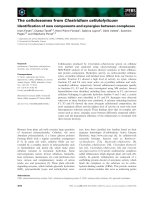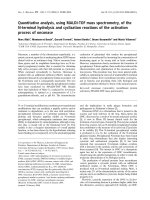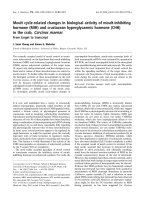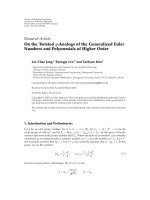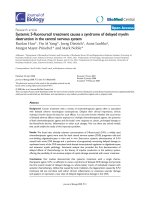Báo cáo sinh học: " Computing inbreeding coefficients quickly B Tier University of New England, Animal Genetics and Breeding Unit Arnaidade, NSW, Australia" pot
Bạn đang xem bản rút gọn của tài liệu. Xem và tải ngay bản đầy đủ của tài liệu tại đây (470.99 KB, 12 trang )
Original
article
Computing
inbreeding
coefficients
quickly
B Tier
University
of New
England,
Animal
Genetics
and
Breeding
Unit
*
Arnaidade,
NSW,
Australia
(Received
13
June
1988;
accepted
12
September
1990)
Summary -
An
algorithm
for
computing
inbreeding
coefficients
(F)
for
all
animals
of
large
populations
is
described.
The
technique
relies
on
the
subset
of
the
numerator
relationship
matrix
(A)
required
to
compute
its
diagonal,
which
contains
F.
A
simple
example
illustrates
that
this
subset
is
a
very
small
part
of
A.
inbreeding
coefficients
/
fast
algorithm
Résumé -
Calcul
rapide
des
coefficients
de
consanguinité.
On
présente
un
algorithme
pour
calculer
rapidement
les
coefficients
de
consanguinité
de
tous
les
anirrcaux,
dans
une
grande
population.
La
méthode
fait
seulement
intervenir
le
sous-ensemble
de
la
matrice
des
coefficients
de
parenté
qui
est
nécessaire
au
calcul
de
sa
diagonale,
qui
contient
les
coefficients
de
consanguinité.
Un
exemple
simple
illustre
que
ce
sous-ensemble
n’est
qu’une
petite
partie
de
la
matrice
des
coefficients
de
parenté.
L’algorithme
est
précisé
sous
la
forme
d’un
codage
symbolique.
coefficients
de
consanguinité
/ calcul
rapide
INTRODUCTION
Wright’s
(1922)
coefficient
of
inbreeding
(F)
describes
the
probability
that
2
alleles
at
any
locus
are
identical
by
descent.
Inbred
offspring
result
from
mating
two
animals
which
have
one
(or
more)
common
ancestors.
Breeders
of
livestock
perceive
inbreeding
as
being
deleterious
and
consequently
try
to
avoid
mating
close
relatives.
The
relationship
between
prospective
mates
can
be
computed
to
determine
the
degree
of
inbreeding
of
the
resulting offspring
from
such
a
mating.
For
inbred
populations,
inbreeding
coefficients
are
required
to
compute
A-
1
directly
using
Henderson’s
(1975)
rules.
Henderson
(1976)
showed
the
relationship
between
the
inbreeding
coefficients
of
an
animal’s
parents
and
the
&dquo;contributions&dquo;
*
AGBU
is
a
joint
venture
between
the
University
of
New
England
and
NSW
Department
of
Agriculture
and
Fisheries.
that
each
animal’s
pedigree
makes
to
!4 !.
For
the
ith
animal
with
parents j
and
k,
the
following
contributions
are
added
to
A-
1:
where
d
ii =
1.0 -
0.25(a!!
+
a
kk).
Two
algorithms
are
commonly
used
to
compute
inbreeding
coefficients.
Origi-
nally
they
were
calculated
using
the
path
coefficient
method
(Wright,
1922).
While
this
method
is
easy
to
use
for
computing
F
for
animals
which
have
few
ancestors
and
are
only
slightly
inbred,
it
is
a
very
complex
method
for
animals
with
many
common
ancestors.
A
simpler
approach
is
to
generate
the
numerator
relationship
matrix
(A)
using
the
tabular
method
as
attributed
to
Lush
by
Emik
and
Terrill
(1949,
cited
by
Hudson
et
al,
1982).
Inbreeding
coefficients
can
be
computed
from
the
diagonal
elements
of
A :
Fi
=
a
ii -
1.
This
paper
describes
an
efficient
imple-
mentation
of
the
tabular
method.
COMPUTING
INBREEDING
COEFFICIENTS
USING
THE
TABULAR
METHOD
To
compute
A
by
the
tabular
method
animals
in
the
population
must
be
numbered
from
1
to
N
so
that
parents
precede
their
progeny.
The
pedigrees
of
all
animals
must
be
stored
in
memory.
A
zero
in
the
pedigree
denotes
an
unknown
parent.
The
upper
triangle
of
A
can
be
computed
on
a
row
by
row
basis
in
consecutive
order
working
from
first
to
last.
Diagonal
elements
are
computed
using
the
formula:
The
remainder
of
the
row
(to
the
right
of
the
diagonal)
can
be
computed
by
applying
the
formula:
where
p
and
q
are
the
parents
of
the
jth
animal
and
i <
j.
If
either
parent
is
unknown
(p
or
q
=
0)
then
a
oi =
0.
When
a
row
is
complete
the
corresponding
column
in
the
lower
triangle
can
be
completed
by
symmetry.
Because
A
is
symmetric
it
is
only
necessary
to
store
the
upper
(or
lower)
triangle.
Table
II
illustrates
A
for
the
sample
population
shown
in
table
I.
The
storage
required
to
compute
A
is
proportional
to
the
square
of
the
numbers
of
animals
and
so
limits
the
size
of
the
population
for
which
A
can
be
computed.
Using
the
technique
of
Hudson
et
al
(1982)
memory
is
only
required
to
store
the
non-
zero
elements
of
A
and
it
can
be
computed
for
larger
populations.
When
inbreeding
coefficients
only
are
required
then
it
is
not
necessary
to
compute
A
completely,
nor
all
its
non-zero
elements.
THE
RECURSIVE
PEDIGREE
METHOD
This
is
an
adaptation
of
the
tabular
method
and
depends
upon
computing
the
subset
of
A
required
to
compute
its
diagonal.
As
each
animal’s
pedigree
is
read,
Equation
1
is
used
to
identify
the
element
which
describes
the
relationship
between
its
parents.
If
the
animal’s
inbreeding
coefficient
is
already
known
and
no
new
ancestral
information
is
available
it
is
stored.
If
not,
then
the
element
(apq)
is
placed
in
the
subset
(flagged)
to
be
computed.
Equation
2
can
now
be
applied
to
identify
those
elements
required
to
compute
elements
already
flagged.
This
requires
searching
the
matrix
(upper
triangle)
from
bottom
to
top
and
from
right
to
left.
As
each
identified
element
is
found
the
two
elements
required
to
apply
equation
2
can
also
be
flagged.
Because
these
two
elements
lie
to
the
left
of
the
flagged
element -
animals
are
numbered
so
that
parents
precede
their
progeny -
searching
A
in
this
manner
results
in
all
the
elements
required
to
compute
the
diagonal
of
A
being
identified.
The
flagged
subset
can
now
be
computed
by
applying
equations
1
and
2
starting
with
the
first
row,
and
proceeding
sequentially
to
the
last.
Computation
of
each
row
of
A
can
be
considered
in
3
parts.
Firstly,
elements
on
the
left
of
the
diagonal
have
already
been
computed -
they
were
on
the
right
of
the
diagonal
in
earlier
rows.
Secondly,
the
off-diagonal
element
(ajk
)
required
to
compute
the
diagonal
element
(aii
)
has
already
been
computed
(j, k
<
i)
and
a
ii
can
be
computed
by
equation
1.
Lastly,
the
flagged
elements
on
the
right
of
the
diagonal
can
be
computed
using
equation
2.
Table
III
illustrates
the
recursive
pedigree
method
for
the
sample
population.
Firstly,
off
diagonal
elements
from
(1)
are
identified
and
flagged.
Because
animals
1,
2
and
3
have
at
least
1
unknown
parent
they
are
not
inbred
and
1
is
stored
in
the
corresponding
diagonal
element.
The
diagonal
elements
of
animals
4, 5,
6 and
7
are
represented
by
the
letters
P,
Q,
R and
S
respectively.
The
offdiagonal
elements
required
to
compute
them
are
represented
by
the
same
letter
in
lowercase.
Other
elements
identified
by
t,
u,
v and
w are
required
to
compute
p,
q,
r and
s.
As
the
rows
are
processed,
elements
that
must
be
computed
before
the
current
element
can
be
computed
are
identified
and
flagged.
a
S6
(s)
is
the
first
flagged
element
to
be
found.
It
requires
that
a
35
(t)
and
a
45
(u)
are
known.
Table
IV
illustrates
the
identification
and
flagging
of
new
elements
as
they
were
found
using
the
search
procedure
described
above.
COMPUTATIONAL
CONSIDERATIONS
To
take
advantage
of
the
saving
in
space
offered
by
this
method
it
is
necessary
to
use
a
sparse
storage
technique
to
store
the
subset
of
A.
In
this
case,
elements
in
the
subset
to
the
right
of
the
diagonal
in
each
row
of
A
can
be
stored
as
a
linked
list.
Elements
in
a
linked
list
are
not
stored
in
memory
in
any
particular
order
but
are
linked
together
in
some
sequence
by
pointers.
There
is
a
pointer
to
the
location
in
memory
of
the
first
element
in
each
row.
Each
element
in
the
list
has
an
associated
pointer
to
the
location
in
memory
of
the
next
element
in
the
sequence.
The
pointer
associated
with
the
last
element
in
each
row
(list)
is
0.
To
find
any
element
in
such
a
list
it
is
necessary
to
&dquo;follow&dquo;
the
pointers
until
the
required
element
is
found.
As
new
elements
are
stored
in
a
list
the
pointers
are
adjusted
to
maintain
the
integrity
of
the
sequence
(for
a
detailed
explanation
of
linked
lists
see
Knuth,
1968).
To
expedite
the
searching phase,
the
elements
in
each
row
should
be
linked
in
reverse
column
order
(from
highest
to
lowest,
fig
la).
After
the
subset
has
been
identified
the
pointers
can
be
adjusted
so
that
the
rows
are
linked
in
column
order
(fig
lb).
For
this
application
it
is
desirable
to
have
a
pointer
(called
RECENT
in
the
Appendix)
to
the
most
recently
added
element
as
well
as
a
pointer
(ROW)
to
the
first
element
in
each
list.
As
only
the
upper
triangle
is
stored,
elements
on
the
left
of
the
diagonal
appear
in
the
column
above
the
diagonal.
These
elements
must
be
added
to
the
lists
holding
the
rows
above
the
diagonal.
Because
these
new
elements
will
generally
be
adjacent
to
the
previous
addition
to
that
row
using
this
pointer
(RECENT)
can
avoid
repeated
searching
through
the
lists.
Similarly,
repeated
searching
for
the
same
new
elements
(arising
from
animals
having
the
same
parent)
within
a
row
and
searching
the
row
to
the
right
of
the
current
element
should
also
be
avoided.
Diagonal
elements
can
be
stored
in
a
separate
vector
(DIAG).
This
can
be
used
to
point
to
the
physical
location
in
the
linked
list
of
the
element
required
to
compute
equation
1
until
the
diagonal
element
is
determined.
Because
the
theoretical
maximum
for
a
diagonal
element
is
2.0,
the
first
2
elements
in
the
linked
list
must
be
reserved.
Thus
a
value
greater
than
2
in
the
diagonal
vector
is
a
pointer,
one
less
than
3
is
a
diagonal
element.
As
each
diagonal
element
is
determined
it
can
be
stored
in
this
vector.
Subsequently,
inbreeding
coefficients
can
be
derived
from
this
vector.
An
efficient
method
for
finding
elements
on
the
left
of
the
diagonal
for
any
row
is
required.
One
way
of
doing
this
is
to
adjust
the
pointers
so
that
after
the
elements
in
each
row
have
been
computed
the
elements
on
the
right
of
the
diagonal
are
relinked
on
a
column
basis
in
reverse
row
order
(fig
Ic).
This
requires
a
vector
(COLUMN)
which
points
to
the
most
recently
added
element
of
each
column.
SIMULATION
STUDY
For
this
example
a
population
with
the
following
characteristics
was
simulated.
Starting
with
a
base
population
of
20
sires
and
500
dams,
40
years
of
progeny
were
generated.
The
adult
population
was
held
constant
at
20
sires
and
500
dams.
Sires
were
mated
randomly
to
the
dams,
all
of
which
had
1
calf.
After
each
year
the
oldest
half
of
the
sires
were
replaced
and
the
oldest
quarter
of
the
dams
were
culled.
Yearlings
(offspring
from
the
previous
&dquo;year&dquo;)
were
randomly
selected
to
replace
the
culled
animals.
As
a
result,
some
animals
had
up
to
20
generations
of
ancestors.
Three
sets
of
inbreeding
coefficients
were
computed
for
the
animals,
viz
-
after
each
group
of
10
years
assuming
that
no
inbreeding
coefficients
had
been
calculated
on
this
population
before;
-
for
each
decade
assuming
that
inbreeding
coefficients
had
been
calculated
in
the
previous
year
ie
only
inbreeding
coefficients
for
the
latest
group
of
calves
were
unknown;
for
parents
only
when
no
inbreeding
coefficients
were
known.
A
detailed
algo-
rithm
used
to
compute
inbreeding
is
shown
in
the
Appendix.
These
computations
were
carried
out
on
a
GOULD
NP1
computer
and
the
results
from
this
are
shown
in
table
V.
For
the
population
of
20 520
animals,
the
subset
of
A
included
516 435
elements
out
of
a
total
of
421070 400
(0.123%).
The
population
size
which
required
com-
putation
of
the
largest
proportion
of
A
(0.146%)
was
10 520. When
inbreeding
coefficients
were
known
for
all
but
the
most
recent
group
of
calves,
or
were
only
required
for
parents,
a
significantly
smaller
proportion
of
A
was
required.
DISCUSSION
The
results
in
table
V
illustrate
how
very
small
a
subset
of
A
is
required
to
compute
its
diagonal
for
the
simulated
population.
Although
the
subset
is
small
as
a
proportion
of
A,
more
than
6
Mbytes
of
memory
were
required
to
store
the
largest
subset
(516 435
elements).
Table
Vb
illustrates
the
computing
resources
required
when
inbreeding
coefficients
are
known
for
all
but
the
most
recent
group
of
calves.
As
this
technique
can
make
use
of
previously
computed
inbreeding
coefficients,
problems
that
are
too
large
for
a
computer
can
be
divided
into
a
series
of
smaller
problems.
To
avoid
repeated
computation
of
the
same
elements
of
A,
subsets
should
not
be
chosen
on
a
chronological
basis
but
rather
on
a
related
group,
herd
or
family
basis.
The
technique
could
be
readily
adapted
to
compute
any
subset of
A
that
is
of
interest.
ACKNOWLEDGMENTS
The
financial
support
of
the
Australian
Meat
and
Livestock
Corporation
is
grate-
fully
acknowledged,
as
are
helpful
comments
and
encouragement
.from
colleagues
and
referees.
REFERENCES
Henderson
CR
(1975)
Rapid
method
for
computing
the
inverse
of
a
relationship
matrix.
J
Dairy
Sci
58,
1727-1730
Henderson
CR
(1976)
A
simple
method
for
computing
the
inverse
of
a
numerator
relationship
matrix
used
in
prediction
of
breeding
values.
Biometrics
32,
69-83
Hudson
GFS,
Quaas
RL,
Van
Vleck
LD
(1982)
Computer
algorithm
for
the
recursive
method
of
calculating
large
numerator
relationship
matrices.
J
Dairy
Sci
65,
2018-
2022
.
Knuth
DE
(1968)
The
art
of
Computer
Programming.
Tlol
1.
Fundamental
Algo-
rithms.
Addison
Wesley,
Reading,
Massachussets.
634
p
Wright
S
(1922)
Coefficients
of
inbreeding
and
relationships.
Am
Nat
56,
330-338
APPENDIX
Algorithm
for
the
recursive
pedigree
method.
Table
VI
illustrates
the
state
of
the
storage
at
various
stages
of
the
algorithm.
The
following
variables
and
subroutine
are
required
for
this
algorithm:
Integer
scalars
N
is
the
number
of
animals.
LLSIZE
is
a
pointer
to
the
last
element
in
the
linked
list
at
any
time
((LLSIZE+1)
is
empty).
LARGE
is
the
size
of
the
vectors
used
to
store
the
lists.
LASTEL
holds
the
address
of
the
last
element
passed
to
the
subroutine.
Integer
vectors
SIRE(0:N)
and
DAM(O:N)
store
parents
(SIR.E(0)=DAM(0)=0).
During
the
search-
ing
phase,
COLUMN(O:N)
is
used
to
keep
a
record
of
the
flagged
elements
in
a
row;
during
the
computation
phase
it
stores
pointers
to
the
first
element
in
the
columns
of
elements
above
the
diagonal.
ROW(1:N)
stores
pointers
to
the
first
element
in
each
row
on
the
right
of
the
diagonal.
RECENT(1:N)
stores
pointers
to
the
location
of
the
elements
preceding
the
most
recently
added
element
in
each
row.
NEXT(1:LARGE)
stores
pointers
to
the
next
element
in
each
row.
JAY(1:LARGE)
stores
the
column
subscripts
of
the
elements.
Real
vectors
WORK(1:N)
is
used
as
workspace
for
computing
a
row.
DIAG(1:N)
stores
pointers
to
the
apq’s
of
equation
[1]
initially,
and
subsequently
the
diagonal
elements
when
computed.
AIJ(1:LARGE)
stores
the
required
elements
of
A.
Subroutine
RESERVE
reserves
space
in
the
linked
lists
for
the
elements
in
the subset
while
maintaining
the
integrity
of
the
lists.
A
check
to
ensure
that
there
is
sufficient
space
to
complete
the
analysis
could
be
included.
RESERVE
requires
access
to
the
global
variables
LLSIZE,
LASTEL,
LARGE,
ROW,
RECENT,
NEXT,
JAY
and
AIJ.
(SUBROUTINE
RESERVE(INI,INJ)
If
(INI=0)
or
(INJ*0)
RETURN
If
(INI=INJ)RETURN
I=MIN(INI,INJ);J=MAX(INI,INJ);
L=RECENT
(I);M=NEXT(L);
IF
(JAY(M)<J)
THEN
L O;M=R
OW
(I)
Endif
If M=0 then
LLSIZE=LLSIZE+ l;JA Y(LLSIZE)=J;ROW(I)=LLSIZE;LAS1EL=LLSIZE
Else
While
(M>0)
and
(JAY(M)>J)
do
RECENT(I)=L;L=M;M=NEXT(M);Endwhile
If
JAY(M)#J
then
LLSIZE=LLSIZE+1;JAY(LLSIZE)=J;LASTEL=LLSIZE
IF
L=0
Then
NEXT(LLSIZE)=
ROW
(I
);RO
W(I)=LLSIZE
Elseif
M!
then
NEXT(L)=LLSIZE
Else
NEXT(LLSIZE)=NEXT(L);NEXT(L)=LLSIZE
Endif
Else
LASTEL=M
Endif
Endif
ENDreserve)
Algorithm
Table
VI
illustrates
the
state
of
the
vector
during
the
algorithm
for
the
sample
population.
At
the
conclusion
of
the
following
steps
DIAG
contains
the
diagonal
of A:
1
Number
animals
1
to
N
so
that
parents
precede
their
progeny.
2
Reserve
the
first
two
locations
in
the
linked
list
(LLSIZE=2).
3
Read
and
store
the
pedigrees
in
SIRE
and
DAM.
(3a.
Read
any
known
inbreeding
coefficients,
add
1
and
store
in
DIAG
(DIAG(I)=1+F
I
)).
4
Reserve
space
in
the
lists
for
parental
relationships
when
both
parents
are
known.
When
either
the
sire
or
dam
is
unknown
store
1.0
in
DIAG.
(For
1=1
to
N
do
If D1AG(I)=0.0 then
If
(SIRE(I)=0)
or
(DAM(I)=O)
then
DIAG(I)=I.0
Else
CALL
RESERVE(SIRE(I),DAM(I));DIAG(I)=LASTEL
Endif
Endif
Endfor)
5
Pass
through
each
row
from
right
to
left
starting
with
the
Nth
row
and
moving
upwards,
examine
each
flagged
element
and
reserve
space
in
the
linked
lists
for
any
element
that
is
required
before
the
current
element
can
be
computed.
Keep
a
record
of
all
flagged
elements
in
the
row
(in
COLUMN).
Confine
searching
to
the
left
of
the
current
element.
(For
I=N
downto
1
do
K=ROW(I);
COLUMN(0)=
I
While
K#0
do
COLUMN(JAY(K))=
I
K=NEXT(K);Endwhile
K=ROW(I)
While
K#0
do
JKS=SIRE(JAY(K))
IF
(COLUMN(JKS)!I)
then
If
(JKS>JAY(RECENT(K)))RECENT(I)=K
CALL
RESERVE(JKS,I)
COLUMN(JKS)=I
Endif
JKD=DAM(JAY(K))
IF
(COLUMN(JKD)!I)
then
If
(JKD>JAY(RECENT(K)))RECENT(I)=K
CALL
RESERVE(JKD,I)
COLUMN(JKD)=I
Endif
K=NEXT(K);Endwhile
Endfor)
6
Adjust
pointers
so
that
the
lists
are
linked
in
column
order
and
reset
COLUMN.
COLUMN.
’
COLUMN(0)=0
(For
I=1
to
N
do
COLUMN(I)=0
K=ROW(I);NEW=0
WIIILE
K>0
do
IOLD=NEXT(K);
NEXT(K)=NEW;
NEW=K;
K=IOLD;
Endwhile
ROW(I)=NEW
Endfor)
7
Compute
each
row
starting
with
the
first.
[For
I=1
to N do
a.
Transfer
elements
on
the
left
of
the
diagonal
into
WORK
(K=COLUMN(I)
While
K#0
do
WORK(JAY(K))=AIJ(K);K=NEXT(K);Endwhile)
b.
Compute
the
diagonal
and
store
it
in
WORK.
(If!IAG(I»2.0 )
DIAG(I)=I+AIJ(DIAG(l))/2;
WORK(I)=DIAG(I))
c.
Compute
the
elements
on
the
right
of
the
diagonal
and
store
them
in
WORK
and
AIJ.
Adjust
the
pointers
so
that
elements
on
the
right
of
the
diagonal
in
the
row
are
linked
into
columns.
(K=ROW(I)
While
K#0
do
JK=JAY(K);WORK(JK)=[WORK(SIRE(JK))
+WORK(DAM(JK))]/2
AIJ(K)=WORK(JK);K2=K;K=NEXT(K);
NEXT(K2)=COLUMN(JK)
COLUMN(JK)=K2;JAY(K2)=I;Endwhile)
Endfor]
